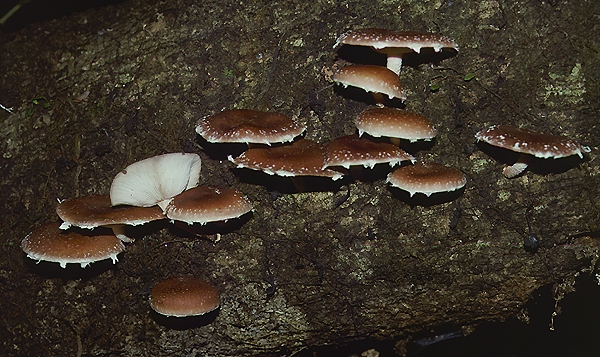
Lentinula lateritia (Berk.) Pegler

Common name: Shiitake or Japanese Mushroom (but see Notes).
Description: The caps may be up to 8 cm in diameter but are commonly 45 cm; they are deep brown, smooth, dry, convex but may expand to plane when old or very large; they are rather tough and when young have a thin white veil stretching from the cap margin to the stem. Young caps are very distinctive with a zone of whitish, fragile scales all around the margins. These scales tend to disappear as the cap ages. The gills are at first attached very narrowly to the stem but soon detach to become free and are coloured white to cream. They become discoloured a little brownish with age. The brownish and quite tough stems are usually 38 mm thick, excentric, and may be up to 7 cm long, often curved so that the cap is placed outwards from the log substrate.
The spores measure 56.5 × 34 µm, are ellipsoidal, smooth and are colourless but white in mass.
Substratum: Lentinula lateritia always occurs on logs in tropical and subtropical rainforest and while it may occur solitary or in twos or threes, it usually fruits prolifically. The logs are always about a year old (i.e. dead but not rotten) so that L. lateritia appears to be one of the initial colonisers of fallen logs.
Distribution: Known only from Queensland and New South Wales.
Notes: There is still some debate as to whether the Australian species is truly separable from L. edodes, the shiitake of Japan. Microscopically, the two are almost indistinguishable and originally, mycologists considered the Australian species a variety of the Japanese species. The Australian species is certainly edible and has been used for food. When fresh, it has a definite odour and a very distinctive taste reminiscent of garlic.
